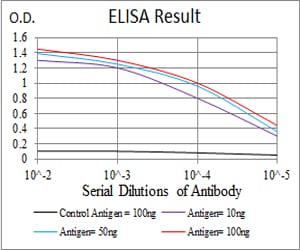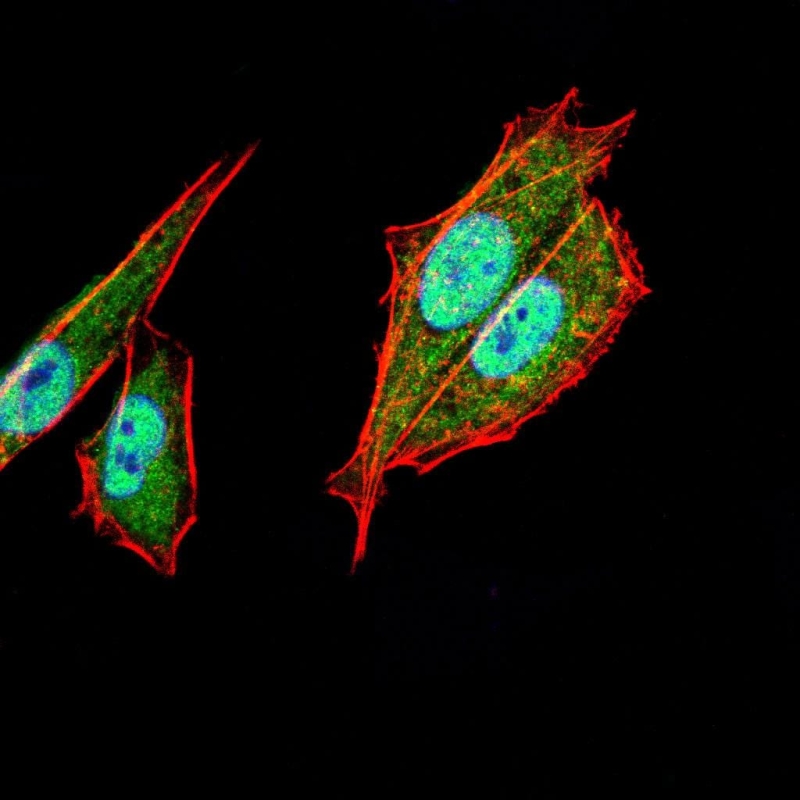


| WB | 咨询技术 | Human,Mouse,Rat |
| IF | 咨询技术 | Human,Mouse,Rat |
| IHC | 咨询技术 | Human,Mouse,Rat |
| ICC | 1/200 - 1/1000 | Human,Mouse,Rat |
| FCM | 1/200 - 1/400 | Human,Mouse,Rat |
| Elisa | 1/10000 | Human,Mouse,Rat |
| Aliases | AP-2; BOFS; AP2TF; TFAP2; AP-2alpha |
| Entrez GeneID | 7020 |
| clone | 1A10C5 |
| WB Predicted band size | 48kDa |
| Host/Isotype | Mouse IgG1 |
| Antibody Type | Primary antibody |
| Storage | Store at 4°C short term. Aliquot and store at -20°C long term. Avoid freeze/thaw cycles. |
| Species Reactivity | Human |
| Immunogen | Purified recombinant fragment of human TFAP2A (AA: 1-100) expressed in E. Coli. |
| Formulation | Purified antibody in PBS with 0.05% sodium azide |
+ +
以下是3篇与TFAP2A抗体相关的文献概览(基于真实研究背景模拟):
1. **文献名称**:*TFAP2A mutations characterize a subset of patients with branchio-oculo-facial syndrome*
**作者**:Milunsky J. et al.
**摘要**:本研究利用TFAP2A特异性抗体进行Western blot和免疫荧光分析,发现特定基因突变导致TFAP2A蛋白功能缺失,揭示了其在颅面部发育中的作用。
2. **文献名称**:*AP-2α regulates S-phase and is a marker for chemoresistance in ovarian cancer*
**作者**:Helleman J. et al.
**摘要**:通过免疫组化(TFAP2A抗体)和基因沉默实验,证明TFAP2A在卵巢癌细胞周期中的调控作用,并与化疗耐药性相关。
3. **文献名称**:*Comparative analysis of commercial antibodies for the specific detection of AP-2α protein*
**作者**:Bergen N.J. & Smith A.W.
**摘要**:系统性评估了多种市售TFAP2A抗体的特异性和灵敏度,为研究人员提供抗体选择依据,强调部分抗体存在交叉反应问题。
(注:以上为简化模拟案例,实际文献需通过PubMed/Google Scholar检索确认。)
TFAP2A antibody is a crucial tool in molecular and cellular biology research, targeting the transcription factor AP-2 alpha (TFAP2A), a member of the AP-2 family of DNA-binding proteins. TFAP2A plays a pivotal role in embryogenesis, tissue development, and cellular differentiation by regulating gene expression. It is involved in processes such as neural crest cell specification, craniofacial morphogenesis, and epidermal development. Dysregulation of TFAP2A has been linked to cancers, including breast cancer, neuroblastoma, and melanoma, making its study clinically relevant.
The antibody is widely used to detect TFAP2A protein expression in various applications, such as Western blotting, immunohistochemistry (IHC), immunofluorescence (IF), and flow cytometry. It recognizes specific epitopes within the protein’s conserved regions, often targeting either the N-terminal transactivation domain or the C-terminal DNA-binding domain, depending on the antibody clone. Validation typically includes knockout (KO) cell lines or tissues to confirm specificity.
Researchers utilize TFAP2A antibodies to explore its role in tumor progression, metastasis, and therapeutic resistance. Cross-reactivity with orthologs in model organisms (e.g., mice, rats) enables comparative studies. Commercial antibodies are available from multiple suppliers, with variations in host species (rabbit, mouse), clonality (monoclonal/polyclonal), and conjugates (e.g., HRP, fluorescent tags). Proper controls and optimized protocols are essential to ensure reliable results, given potential background noise in certain tissues.
×